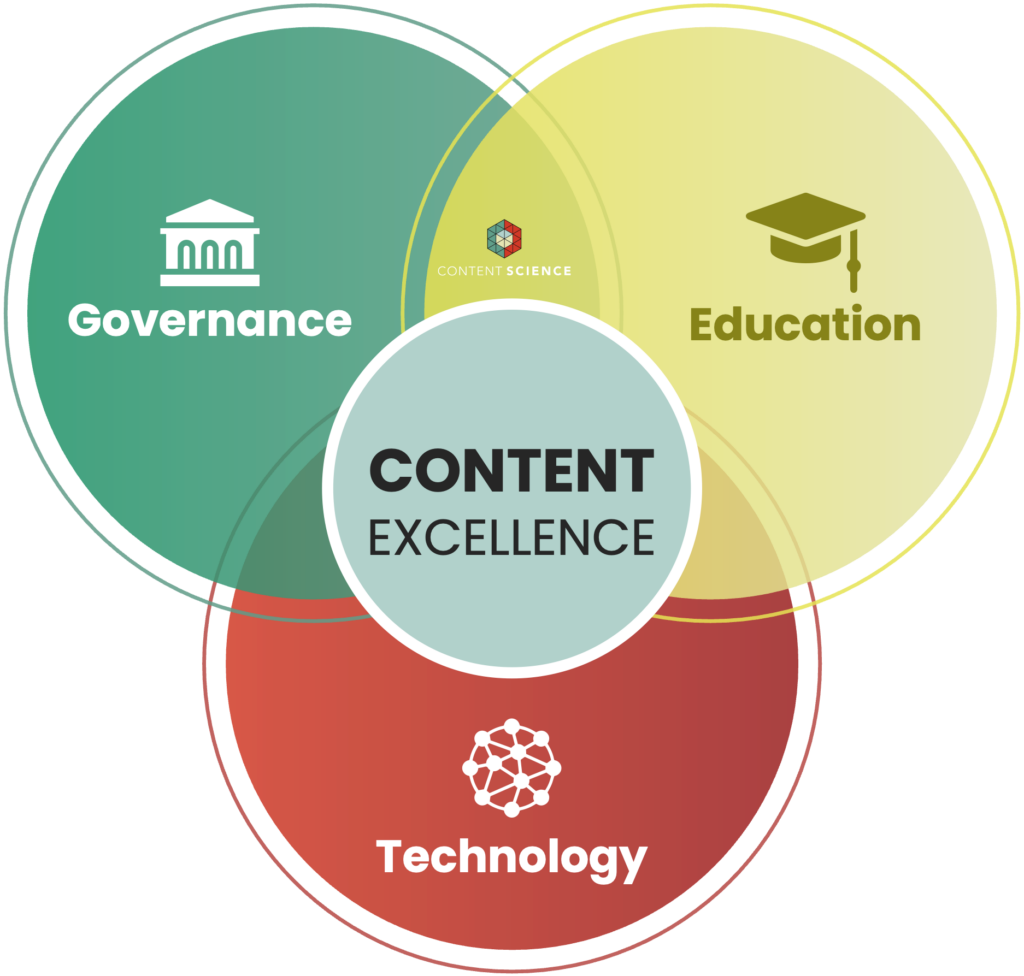
If you’re a professional or leader with an enterprise, chances are you’ve seen content problems like inconsistent style, outdated information, inefficient processes, duplicate efforts, and lack of governance. You’re not alone.
And thanks to those problems, your organization also might face delays in adopting artificial intelligence (AI) because it can’t manage the AI risks.
The bad news is there is no content fairy that can wave a magic wand and instantly make your content excellent at scale—and keep it that way. But there is good news.
Rather than wave a wand, you can establish a center of content excellence. Done well, a center of content excellence can have an impact that seems magical. Let’s take a closer look at what a center of content excellence is and how it can help your organization succeed with content at scale.
Definition of a Center of Content Excellence
At Content Science, we define a center of content excellence this way:
A center of content excellence (CCE) is a hub (virtual or physical) that concentrates expertise and resources to achieve world-class content capability.
In our experience, a CCE addresses content governance, content education / empowerment, and content technology including artificial intelligence.
A CCE brings together people, tools, knowledge, and other kinds of resources around content, focusing and directing them to maximize value. Particularly in larger organizations, content professionals are often embedded throughout teams and departments, but never really connect with each other. A centralized hub can help mitigate the problems that arise from such fragmentation.

A CCE can help bridge silos and foster collaboration in mid to large organizations, as well as provide a forum to facilitate peer review. It’s the ideal hub to manage adherence and changes to style and standards for higher quality and more consistency in best practices.
A center of content excellence also can serve as a space to share knowledge, expertise, and strategy to upskill and empower, including when it comes to onboarding new team members or partners. In addition, a CCE is well placed to set and track KPIs and share lessons learned as a result. And it can assist in securing resources, such as content tools and technology, and using them effectively across the enterprise.
A CCE can bring a host of benefits to your organization, such as Additionally, a CCE is grounded in evidence. In our study of content operations, we identified the top success factors that distinguish organizations reporting the most content success, such as communicating a content vision, having governance, offering content-specific training, and more. We also uncovered challenges everyone else experiences, such as operating in silos, lack of resources, and too much bureacracy. The beauty of a CCE? It addresses the key content operations success factors and overcomes the challenges. Let’s briefly walk through how. We’ve established the importance of a well-communicated content vision. A CCE, by its very design, can help remind people of the vision and reinforce the strategy as well as supporting standards. And it can help break down barriers and aid communication across enterprise silos. Modern content roles call for a variety of skills, and content-specific training is offered by the most successful organizations. What better way to deliver that training than through a dedicated CCE? When it comes to evaluating content impact, the most effective organizations consider return on investment, a metric that a CCE can assist with defining and reporting on. Whatever measures you use, however, a CCE can prove a valuable resource: acting as a source of knowledge, lessons learned, research, results of experiments and testing. These are insights that can be valuable to the organization beyond the single content project or team that originally delivered them. Finally, you can call on the expertise found within a CCE to facilitate effective use of advanced tools and make the most of the resources at your disposal. You can form a committee with a CCE to inform decisions about content tools and technology. You also can encourage wide adoption of selected content tools or technology by adding training resources and sharing tips or best practices to get the most out of them. Now that we’ve established the benefits of a CCE, let’s turn our attention to implementation.
Setting up a center of content excellence often involves steps like these. A CCE could be a relatively informal community of practice, driven by volunteers, with an emphasis on connecting and collaborating. Or at the other end of the spectrum, it could be a formal business unit with its own dedicated team and resources, cross cutting across functions (such as marketing, support, product, and customer success). Often, we help organizations move from an informal approach to a more formal approach.
Let’s discuss the documentation and training further. The documentation and training are the substance of the CCE, so we recommend assembling a bank of these resources before launching. As you consider what topics to cover, consider standards for quality apply to your content. You can learn more about content quality in this article. Documentation can come in many different forms. One form of documentation we find effective is a playbook. A playbook brings standards to life by making them actionable, covering the relevant who, what, when, why, and how. Chances are your organization will need several playbooks. Your playbooks could cover everything from producing and maintaining content in various contexts to standards and guidelines; experimenting and evaluation through to content delivery, automation, and personalization. An outside partner such as Content Science can move your center of excellence effort forward. With a partner, you can What Are the Benefits of a Center of Content Excellence?
Communicating Content Vision and Strategy
Empowering the Right Content Roles
Evaluating or Measuring Content Impact
Getting Smarter about Advanced Content Technology and AI
Establishing a Center of Content Excellence
Sourcing or Creating Documentation for Your CCE
How a Partner Can Help Your CCE
Events, Resources, + More
The Ultimate Guide to End-to-End Content
Discover why + how an end-to-end approach is critical in the age of AI with this comprehensive white paper.
The Content Advantage Book
The much-anticipated third edition of the highly rated book by Colleen Jones is available at book retailers worldwide. Learn more!
20 Signs of a Content Problem in a High-Stakes Initiative
Use this white paper to diagnose the problem so you can achieve the right solution faster.
Upskill with Content Science Academy
Training for modern content roles through on-demand certifications + courses or live workshops.







Comments
We invite you to share your perspective in a constructive way. To comment, please sign in or register. Our moderating team will review all comments and may edit them for clarity. Our team also may delete comments that are off-topic or disrespectful. All postings become the property of
Content Science Review.